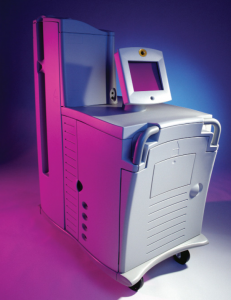![]() ThermoFab® 17-Piece Heart Laser Housing Pressure Formed of Proprietary Thermoplastic Alloy
ThermoFab® 17-Piece Heart Laser Housing Pressure Formed of Proprietary Thermoplastic Alloy
When ThermoFab of Shirley, MA was tapped to thermoform a housing for the second generation of CO2 Heart Lasers, they sought a material exhibiting an unusual combination of physical properties. The second-generation machine was to be some 60% smaller and 1,400 lbs. lighter than the first units marketed – but still would require a major housing assembly. Using Pro-EngineerTM software to tool up the Industrial Design ThermoFab engineers confirmed that the housing needed would measure 711 x 1220 x 1575mm (28″ X 48″ X 62″).
 “We considered using ABS to form the housing assembly,” observes ThermoFab V.P. Sales, Michael Wahl. “But we wanted the most precise rendition of detail possible for the seventeen pieces which compose the unit so that the parts would fit together perfectly. Since these devices are used in operating rooms, we wanted all the resistance to chemicals and solvents that we could get. And, since they’re moved from operating room to operating room repeatedly, they had to stand up to a lot of handling, scraping and abuse.
“We considered using ABS to form the housing assembly,” observes ThermoFab V.P. Sales, Michael Wahl. “But we wanted the most precise rendition of detail possible for the seventeen pieces which compose the unit so that the parts would fit together perfectly. Since these devices are used in operating rooms, we wanted all the resistance to chemicals and solvents that we could get. And, since they’re moved from operating room to operating room repeatedly, they had to stand up to a lot of handling, scraping and abuse.
Heart Laser Creates Circulation Channels
Selecting The Processing Material
The CO2 Heart Laser – created by PLC Medical Systems, Inc. of Franklin, MA. – makes possible new heights of well being for thousands of angina sufferers having areas of myocardium not able to be revascularized by bypass surgery or angioplasty alone. In a process known as Transmyocardial Revascularization (TMR), the machine allows the surgeon to create miniscule channels in the wall of the patient’s left ventricle. These channels can stimu- late measurable perfusion, bring blood to starving tissue and even lay the foundation for vascular growth, thus providing long-lasting pain relief.
Unlike other lasers, the CO2 1,000 watt system is so effective that it allows the surgeon to create a channel with a single millisecond pulse timed to fire only when the heart is at rest. Other heart lasers require multiple pulses and can fire when the heart is beating, increasing the risk of arrhythmia.
“No plastic has better chemical resistance than this alloy,” notes Mike Vitols, ThermoFab’s General Manager. “And, of course, with 500 to 600 units projected each year, injection molding was rejected as too expensive. Pressure forming seemed the only way to go. These thermoplastic alloys are exceptional in their capacity to maintain uniform wall thickness, even in the deepest of parts,” he continues. “So we included them in our evaluations too”.
The search soon narrowed to VinyloyTM Grade 103 – a product of Kleerdex Company, LLC of Bloomsburg, PA. With a tensile strength rating of 41 MPa (6,000 psi) and a flexural strength of 66 MPa (9,500 psi), plus a Modulus of Elasticity of 2,482 MPa (360,000 psi) and Notched Izod Impact resistance of 641 J/m at 23°C (12ft-lbs/in at 73°F) – Vinyloy 103 fit all the requirements. It also carries UL Std. 94V-0 and 5V flammability ratings. “When we noted that the Vinyloy 103 had forming cycle times equivalent to FR-ABS, there was no question,” Mr. Wahl continued. “We could anticipate all the benefits of ABS – plus the superior chemical/solvent resistance of the PVC alloy”.
Early production results confirmed their decision. “We got – and still get – better forming than with other materials we might have used,” Wahl points out. “The Vinyloy moves through the forming process faster and gives us greater uniformity on even the deepest of draws”.
Using PTC/ProEngineerTM software, ThermoFab can go directly from engineering files to CNC machines on the production line. Couple this with a capacity for rapid prototyping, tooling and painting – all in house – and the company can minimize production timelines to meet their customers’ most demanding schedules.
The Heart Laser shipped eight weeks after the project was undertaken. The Heart Laser Housing design won the Thermoforming Institute’s National Award of the year.
